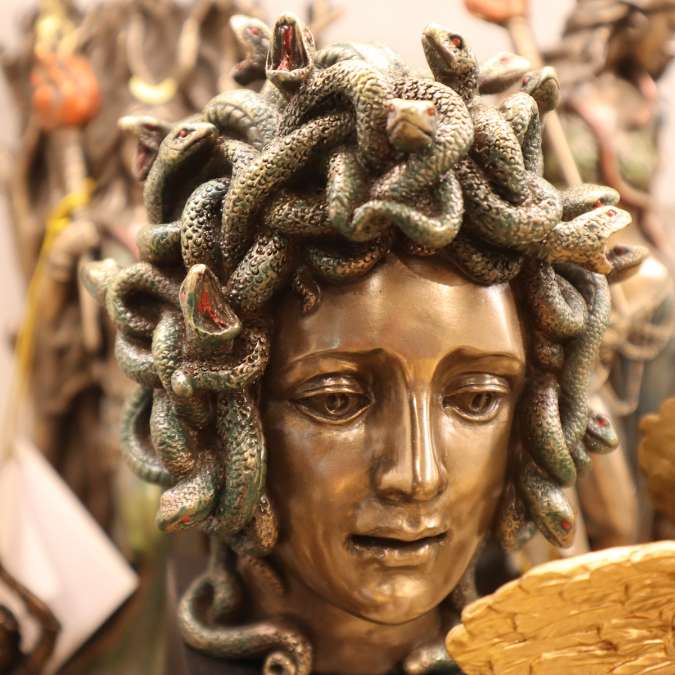
A Journey Through the Dark Side of Art 🎨🖤
Art has always reflected the full range of human emotion — from joy and beauty to suffering, madness, and fear. While many masterpieces celebrate harmony and light, others plunge deep into the shadows of the human psyche, revealing disturbing truths about death, violence, sin, and insanity.
These are the works that fascinate and terrify us in equal measure — the paintings that make us look twice, the sculptures that seem almost alive, and the images that stay in our minds long after we’ve turned away.
In this article, we’ll explore the most unsettling paintings, sculptures, and artistic creations in history, from the nightmarish visions of Hieronymus Bosch to the tortured brushstrokes of Francis Bacon. Each of these works exposes the dark side of art, where beauty meets horror, and creativity becomes a mirror of our deepest fears. 👁️🕯️
🕸️ Why Are We Drawn to Dark Art?
Before exploring the most disturbing works, it’s worth asking: why do we like to be unsettled by art?
Psychologists and art historians suggest several explanations:
- Catharsis: Looking at disturbing art helps us face our fears in a safe, controlled way.
- Curiosity: Humans are naturally fascinated by death, mystery, and the forbidden.
- Aesthetic tension: There’s a strange beauty in horror — in the contrast between terror and artistic mastery.
- Historical and moral reflection: Many of these works were created as warnings or allegories, showing the consequences of sin, war, or madness.
From medieval hellscapes to modern psychological nightmares, dark art forces us to confront what we usually avoid — and that’s precisely why it’s unforgettable.
⚰️ The Dark Side of Art: A Historical Overview
Art’s relationship with darkness has evolved through time:
- Middle Ages: Fear of hell and divine punishment dominated religious art.
- Renaissance: Artists began exploring death and decay alongside ideal beauty.
- Baroque period: Theatrical drama and violent martyrdoms expressed the emotional extremes of faith and sin.
- 19th century: Romanticism and Symbolism introduced madness, dreams, and death as artistic subjects.
- 20th century and beyond: Expressionism and Surrealism delved into psychological horror and existential dread.
Now, let’s dive into the masterpieces that best capture this haunting evolution. 💀
🖼️ 1. The Garden of Earthly Delights – Hieronymus Bosch (c. 1490–1510)
One of the most enigmatic and terrifying paintings ever created, Bosch’s The Garden of Earthly Delights is a triptych that takes viewers from innocence to damnation.
The left panel depicts the creation of humanity, the central one a bizarre paradise of pleasure and sin, and the right — the most famous — an apocalyptic vision of Hell.
🔥 Why it’s unsettling:
Bosch filled his infernal landscape with mutant creatures, grotesque hybrids, and tortured souls, creating a surreal nightmare centuries before surrealism existed.
🕯️ Symbolism:
The painting serves as a moral warning, but it’s also deeply psychological — a vivid portrait of human obsession and self-destruction.
👁️ Where to see it: Museo del Prado, Madrid.
😱 2. Saturn Devouring His Son – Francisco de Goya (c. 1819–1823)
Goya’s horrifying depiction of the Titan Saturn eating his child is one of the most disturbing images in art history.
Painted directly on the walls of his home — known as the Black Paintings — it reflects madness, despair, and a loss of faith in humanity after years of war and personal suffering.
🩸 Why it’s unsettling:
The wild eyes, gory mouth, and raw brushwork express pure, unfiltered horror. This is not a mythological scene; it’s a scream frozen in paint.
🎭 Symbolism:
It represents the destructive power of time, but also Spain’s self-destruction during its political turmoil.
👁️ Where to see it: Museo del Prado, Madrid.
👹 3. The Nightmare – Henry Fuseli (1781)
Fuseli’s The Nightmare is one of the most iconic images of supernatural horror in Western art. It portrays a sleeping woman visited by a demonic creature sitting on her chest, with a ghostly horse emerging from the darkness.
💤 Why it’s unsettling:
The scene captures the paralyzing feeling of night terrors or sleep paralysis, blurring the line between dream and reality.
🕯️ Symbolism:
It reflects repressed sexuality and the subconscious, anticipating Freud’s psychoanalysis by more than a century.
👁️ Where to see it: Detroit Institute of Arts, USA.
🩸 4. Judith Beheading Holofernes – Artemisia Gentileschi (c. 1620)
This Baroque masterpiece depicts the biblical heroine Judith beheading the Assyrian general Holofernes.
Gentileschi’s version is visceral and brutally realistic — far more intense than other artists’ renditions.
🗡️ Why it’s unsettling:
The sheer violence and emotional power of the painting make it impossible to look away. It’s not just gore; it’s rage, justice, and trauma captured in motion.
🔥 Symbolism:
Art historians interpret it as a reflection of female empowerment — Gentileschi herself was a survivor of sexual assault, and this work channels her pain into divine vengeance.
👁️ Where to see it: Uffizi Gallery, Florence.
🕯️ 5. Death and the Miser – Hieronymus Bosch (c. 1485–1490)
Another masterpiece by Bosch, Death and the Miser shows a dying man torn between salvation and greed, as Death stands ready to claim him.
☠️ Why it’s unsettling:
The pale, skeletal Death emerging from the shadows with an arrow feels eerily modern, symbolizing humanity’s eternal fear of dying unprepared.
💰 Symbolism:
It’s a warning against materialism — that no wealth can save us from the inevitable.
👁️ Where to see it: National Gallery of Art, Washington, D.C.
💀 6. The Hands Resist Him – Bill Stoneham (1972)
Known as “the most haunted painting in the world,” this modern work gained fame after stories circulated online claiming it caused strange phenomena in those who owned or viewed it.
The painting shows a young boy and a life-sized doll standing before a glass door, behind which ghostly hands press against the glass.
👁️ Why it’s unsettling:
The uncanny valley effect — familiar yet wrong — gives it a dreamlike horror.
⚡ Cultural impact:
It became an internet legend, symbolizing how modern fear travels through digital folklore.
👁️ Where to see it: Private collection.
🧠 7. Study after Velázquez’s Portrait of Pope Innocent X – Francis Bacon (1953)
Bacon’s reinterpretation of Velázquez’s 17th-century portrait transforms the pope into a screaming, tormented figure trapped in a cage of shadows.
💥 Why it’s unsettling:
It merges power and helplessness, capturing existential terror with nightmarish intensity.
🎭 Symbolism:
Bacon’s distorted forms reflect the post-war trauma of the 20th century — the human soul fractured by violence and guilt.
👁️ Where to see it: Des Moines Art Center, USA.
⚰️ 8. The Isle of the Dead – Arnold Böcklin (1880–1886)
This haunting painting shows a lone figure in white being rowed toward a mysterious island filled with cypress trees and tombs.
🌒 Why it’s unsettling:
The stillness, the silence, and the strange light create an atmosphere of eternal mourning.
🕯️ Symbolism:
It represents the journey to the afterlife — peaceful, yet full of dread.
👁️ Where to see it: Multiple versions exist, including at the Kunstmuseum Basel.
🧟♀️ 9. Medusa – Caravaggio (1597–1598)
Caravaggio’s masterpiece, painted on a shield, captures the exact moment Medusa’s severed head realizes her own death.
⚡ Why it’s unsettling:
Her wide, horrified eyes and frozen scream make the viewer feel both pity and fear.
🎭 Symbolism:
It’s a study of death, power, and the gaze — art as both weapon and reflection.
👁️ Where to see it: Uffizi Gallery, Florence.
10. The Dying Slave – Michelangelo (1513–1516)
While not gruesome, Michelangelo’s sculpture of a young man in his final breath embodies a disturbing beauty.
⚰️ Why it’s unsettling:
The mix of agony and serenity creates a haunting tension — the aestheticization of death.
👁️ Where to see it: Louvre Museum, Paris.
🕯️ Dark Art in Modern Times
Today, artists continue exploring fear, trauma, and mortality through new mediums:
- Damien Hirst’s works with dead animals and formaldehyde provoke reflection on death and decay.
- Jenny Saville’s massive portraits expose the body’s vulnerability with raw realism.
- HR Giger, designer of Alien, created biomechanical nightmares blending flesh and machine.
- Anish Kapoor’s dark voids and mirror installations evoke infinity and annihilation.
In contemporary art, darkness isn’t just horror — it’s a language of truth, confronting what society prefers to hide.
💭 Final Thoughts: The Beauty of Fear
Art’s power lies in its ability to make us feel — even discomfort, even dread. The most unsettling works in art history remind us that beauty and horror are not opposites, but partners in revealing the human condition.
From Bosch’s medieval hells to Bacon’s existential screams, these masterpieces whisper the same message:
👉 to look at darkness is to understand what it means to be human.
So, next time you visit a museum, pause before the eerie and the grotesque.
You might find that the scariest art isn’t just about death — it’s about life itself. 🖤🎨
Sources:
- Museo del Prado official archives (2024)
- The Metropolitan Museum of Art Collection Notes (2023)
- The Art Newspaper: The enduring appeal of dark art (2023)
- Tate Modern: Francis Bacon Exhibition Guide (2022)
- National Gallery of Art: The Nightmares of Bosch and Beyond (2024)
- BBC Culture: Why disturbing art fascinates us (2024)

